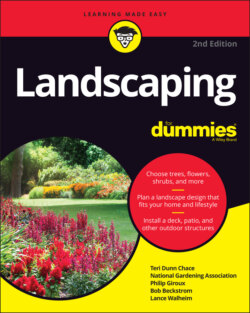Читать книгу Landscaping For Dummies - Lance Walheim - Страница 51
Layering Plants to Add Interest
ОглавлениеLayering your landscape with plants of different heights definitely improves its look and, indeed, makes it a more comfortable place to be. Groundcovers and grass form the lowest layer, followed by flowering perennials and annuals, then shrubs, then small trees, then medium trees, and then venerable tall trees.
You can also substitute structures for any of the plants: a pedestal birdbath for a mid-height shrub, for instance, or a vine-covered wall or fence for a small tree. A side benefit of this technique is that it leaves room for filtered sunlight and walking paths. (Refer to the section, “Adding Décor to Your Design: How Many Pink Flamingos Are Enough?,” earlier in this chapter if you do add décor.)
Think of layers as you plan the general look of your landscape. Your pencil plan shows only a flat oval for a flowerbed, but in your mind, that flat shape should be three-dimensional, with roses or other flowering shrubs rising above the perennials, and small trees or trellises adding even more height to the bed. Layering not only adds height to your landscape, which instantly makes it more interesting, but it also lets you wedge in more plants than a design that calls for side-by-side planting.
When layering plants in your landscape, keep these suggestions in mind:
Anchor large, old shade trees to your garden. Big, old shade trees are a great asset, but they can be frustrating to work into a landscape plan because their size makes them stick out. An easy solution is to set up some nonplant items underneath, such as a bench, bistro table and chairs, or a hammock to help integrate it into its surroundings.
Plant smaller trees beside your giant tree and shrubs beside the shorter trees. This is a little trick called stepping down, effectively connecting your big tree to the rest of the garden so your gaze makes a transition to the tops of the trees in graduated steps instead of one giant leap. For instance, consider planting redbuds beneath a big maple tree. You can also use horizontal visual weight to balance height.
When you add smaller plants, they tend to adjust better to transplanting and grow faster. We know you’re bearing their projected mature size in mind, and you’re willing to be patient. An added bonus: Smaller plants are less expensive.
Layered planting has another important side benefit: It’s good for the birds. Birds like to ladder their way down into a yard, checking their surroundings for safety as they go, heading for their next meal or your birdbath for a dip. (For about making a bird-friendly landscape, see Chapters 12 and 20.)
